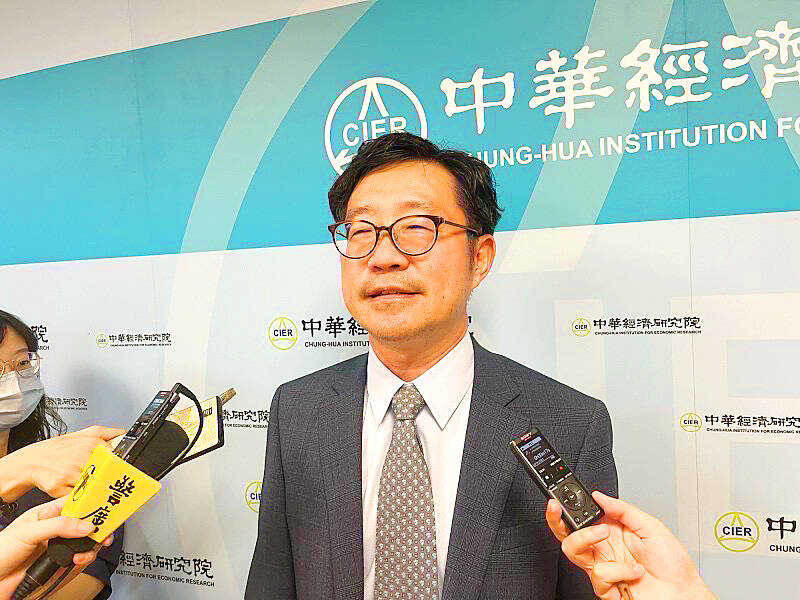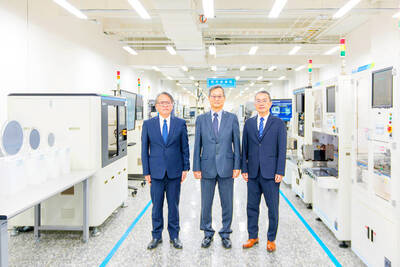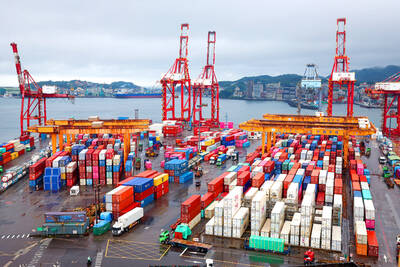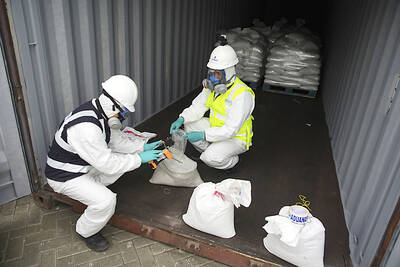The Chung-Hua Institution for Economic Research (CIER, 中華經濟研究院) yesterday trimmed its forecast for Taiwan’s GDP growth this year from 3.22 percent to a range of 2.85 percent to 0.16 percent, depending on how US tariffs settle and affect Taiwan and the world.
It is the first time the Taipei-based think tank laid out a growth range rather than a clear-cut figure, saying it is extremely difficult to arrive at a conclusion given US President Donald Trump’s unpredictable trade policy.
“The only certainty is that [Taiwan’s] GDP growth is set to slow while inflation pressure would go up,” CIER researcher Peng Su-ling (彭素玲) told a media briefing.

Photo: Hsu Tzu-ling, Taipei Times
Trump on April 2 announced a 32 percent tariff on imports from Taiwan, but one week later introduced a 90-day suspension for major trading partners except China.
Despite the respite, uncertainty surrounding global trade has rattled corporate confidence, especially in trade-reliant economies.
In a worst-case scenario, Taiwan’s GDP growth could falter to just 0.16 percent this year, if global trade tensions escalate into a full-blown recession or stagflation, CIER president Lien Hsien-ming (連賢明) said.
The biggest problem right now is uncertainty, leaving local manufacturers hesitant to make new investments or other major decisions because the future is so murky and fluid, the academic said, adding that the chance of the worst-case scenario is low at 10 to 20 percent.
The 90-day suspension has brought a wave of urgent orders to Taiwanese firms, but Lien said the momentum is unlikely to sustain for long.
It is too early to tell how Taiwan would emerge from the US-China trade war, though the country is receiving short-term benefits in the form of order transfers, Lien said.
Taiwan’s heavy reliance on both the US and China as key export destinations leaves it particularly exposed, the academic added.
In an optimistic case, Taiwan could achieve GDP growth of 2.85 percent this year, providing technology and consumer electronics products are exempted from extra tariffs other than the universal 10 percent, and the world dodges a recession, the CIER said.
The baseline case assumes higher, but still competitive tariff rates for Taiwanese goods, and the nation’s GDP growth would therefore manage to reach 1.66 percent, Lien said.
The Trump administration has not yet arrived at a final decision on whether to impose tariffs on semiconductors and how much if the answer is positive.
Lien expressed cautious optimism that Washington and Beijing would eventually seek a negotiated settlement, as a prolonged confrontation would inflict economic damage on both sides.
CIER is looking at an increase of 1.99 percent to 2.08 percent in the consumer price index this year, it said.
Volatility is likely to persist in the short term, making close monitoring of trade developments critical for Taiwan’s policymakers and businesses, Lien said.

SMART MANUFACTURING: The company aims to have its production close to the market end, but attracting investment is still a challenge, the firm’s president said Delta Electronics Inc (台達電) yesterday said its long-term global production plan would stay unchanged amid geopolitical and tariff policy uncertainties, citing its diversified global deployment. With operations in Taiwan, Thailand, China, India, Europe and the US, Delta follows a “produce at the market end” strategy and bases its production on customer demand, with major site plans unchanged, Delta president Simon Chang (張訓海) said on the sidelines of a company event yesterday. Thailand would remain Delta’s second headquarters, as stated in its first-quarter earnings conference, with its plant there adopting a full smart manufacturing system, Chang said. Thailand is the firm’s second-largest overseas

‘REMARKABLE SHOWING’: The economy likely grew 5 percent in the first half of the year, although it would likely taper off significantly, TIER economist Gordon Sun said The Taiwan Institute of Economic Research (TIER) yesterday raised Taiwan’s GDP growth forecast for this year to 3.02 percent, citing robust export-driven expansion in the first half that is likely to give way to a notable slowdown later in the year as the front-loading of global shipments fades. The revised projection marks an upward adjustment of 0.11 percentage points from April’s estimate, driven by a surge in exports and corporate inventory buildup ahead of possible US tariff hikes, TIER economist Gordon Sun (孫明德) told a news conference in Taipei. Taiwan’s economy likely grew more than 5 percent in the first six months

SUPPLY RESILIENCE: The extra expense would be worth it, as the US firm is diversifying chip sourcing to avert disruptions similar to the one during the pandemic, the CEO said Advanced Micro Devices Inc (AMD) chief executive officer Lisa Su (蘇姿丰) on Wednesday said that the chips her company gets from supplier Taiwan Semiconductor Manufacturing Co (TSMC, 台積電) would cost more when they are produced in TSMC’s Arizona facilities. Compared with similar parts from factories in Taiwan, the US chips would be “more than 5 percent, but less than 20 percent” in terms of higher costs, she said at an artificial intelligence (AI) event in Washington. AMD expects its first chips from TSMC’s Arizona facilities by the end of the year, Su said. The extra expense is worth it, because the company is

The seizure of one of the largest known mercury shipments in history, moving from mines in Mexico to illegal Amazon gold mining zones, exposes the wide use of the toxic metal in the rainforest, according to authorities. Peru’s customs agency, SUNAT, found 4 tonnes of illegal mercury in Lima’s port district of Callao, according to a report by the non-profit Environmental Investigations Agency (EIA). “This SUNAT intervention has prevented this chemical from having a serious impact on people’s health and the environment, as can be seen in several areas of the country devastated by the illegal use of mercury and illicit activities,”